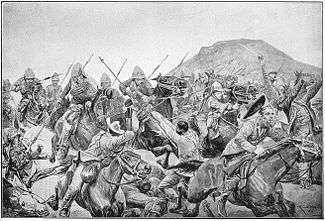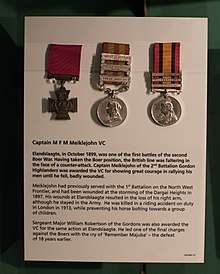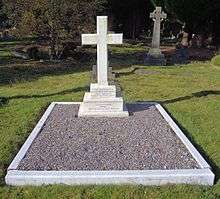Matthew Fontaine Maury Meiklejohn
Major Matthew Fontaine Maury Meiklejohn VC (/ˈmiːkəlˌdʒɒn/; 27 November 1870 – 4 July 1913[1]) was a British recipient of the Victoria Cross, the highest and most prestigious award for gallantry in the face of the enemy that can be awarded to British and Commonwealth forces.
Matthew Fontaine Maury Meiklejohn | |
|---|---|
 The battle of Elandslaagte | |
| Born | 27 November 1870 Clapham, London |
| Died | 4 July 1913 (aged 42) Hyde Park, London |
| Buried | |
| Allegiance | |
| Service/ | |
| Years of service | 1891 - 1913 |
| Rank | Major |
| Unit | The Gordon Highlanders |
| Battles/wars | Chitral Expedition Tirah Campaign Second Boer War |
| Awards | Victoria Cross |
Details

Meiklejohn was the son of Professor John Meiklejohn, of the University of St. Andrews, and was educated at Madras College and Fettes College. He was 28 years old, and a Captain in the 2nd Battalion, The Gordon Highlanders, British Army during the Second Boer War when the following deed took place at the Battle of Elandslaagte for which he was awarded the VC.
At the Battle of Elandslaagte on the 21st October, 1899, after the main Boer position had been captured, some men of the Gordon Highlanders, when about to assault a kopje in advance, were exposed to a heavy cross-fire and, having lost their leaders, commenced to waver. Seeing this, Captain Meiklejohn rushed to the front and called on the Gordons to follow him. By his conspicuous bravery and fearless example, he rallied the men and led them against the enemy's position, where he fell, desperately wounded in four places.[2]
His VC action cost him his arm which was amputated. Despite this, he remained in the army as a staff officer. He was promoted to the substantive rank of Captain of the Gordon Highlanders 22 January 1902,[3] and was seconded as a staff officer posted at Saint Helena.[4] He later achieved the rank of major.[5]
His Victoria Cross is displayed at the Gordon Highlanders Museum along with his campaign medals.[6]
Further information

His death occurred when he was riding his horse in Hyde Park and it bolted. With only one arm to control the horse, he took the choice to steer it into some cast iron railings, in order to avoid a nursemaid who was pushing a baby in her pram. This was considered to be an act of high bravery and cost him his life. He died on 4 July 1913 and was given a hero's funeral in Brookwood Cemetery. He is commemorated by a plaque on the wall of the Hyde Park Barracks, London.
Notes
- Who's Who 1914, p. xxiii, gives 3 July as the date of death
- "No. 27212". The London Gazette. 20 July 1900. p. 4509.
- "No. 27413". The London Gazette. 4 March 1902. p. 1540.
- "No. 27419". The London Gazette. 25 March 1902. p. 2075.
- "No. 28314". The London Gazette. 3 December 1909. p. 9233.
- "The Victoria Cross". The Gordon Highlanders Museum. Retrieved 17 September 2017.
References
- Monuments to Courage (David Harvey, 1999)
- The Register of the Victoria Cross (This England, 1997)
- Victoria Crosses of the Anglo-Boer War (Ian Uys, 2000)
External links
- angloboerwar.com
- Location of grave and VC medal (Brookwood Cemetery)
- The Brookwood Cemetery Society (Known Holders of the Victoria Cross Commemorated in Brookwood Cemetery)